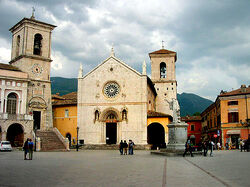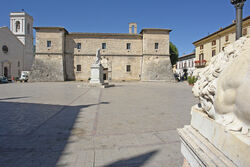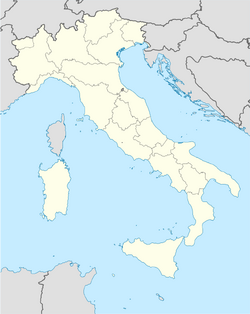| Main | Births etc |
|---|
| Norcia Comune di Norcia |
|
|---|---|
| Coordinates: | |
| Country | Italy |
| Region | Umbria |
| Province | Terni |
| Commune | Norcia |
| Frazioni | List
Agriano,
Aliena, Ancarano, Biselli, Campi, Casali di Serravalle, Case sparse, Castelluccio, Cortigno, Forca Canapine, Forsivo, Frascaro, Legogne, Monte-Cappelletta, Nottoria, Ocricchio, Ospedaletto, Pescia, Pie' la rocca, Piediripa, Popoli, San Marco, San Pellegrino, Sant'Andrea, Savelli, Serravalle, Valcaldara |
| Government | |
| • Mayor | Gian Paolo Stefanelli |
| Area | |
| • Total | 274 km2 (106 sq mi) |
| Population | |
| • Total | 4,695 |
| Time zone | CET (UTC+1) |
| • Summer (DST) | CEST (UTC+2) |
| Postal code | 06046 |
| Area code | 0743 |
| Website | [official website |

The church of St. Benedict, facing Piazza San Benedetto, in Norcia.

The Castellina.
Norcia is a town and comune in the province of Perugia (Italy) in southeastern Umbria, located in a wide plain abutting the Monti Sibillini, a subrange of the Apennines with some of its highest peaks, near the Sordo River, a small stream that eventually flows into the Nera. The town is thus popularly associated with the Valnerina (the valley of that river).
The area is known for its air and scenery, and is a base for mountaineering and hiking. It is also widely known for hunting, especially of the wild boar, and for sausages and ham made from wild boar and pork, to the point that Norcia has given its name to such products: in Italian, norcineria.
History[]
Traces of human settlement in Norcia's area dates back to the Neolithic Age.
The town's history begins with settlement by the Sabines in the 5th century BC. It became an ally of ancient Rome in 205 BC, during the Second Punic War, when it was known in Latin as Nursia, but the earliest extant Roman ruins date from around the 1st century.
St. Benedict, the founder of the Benedictine monastic system, and his twin sister St. Scholastica, were born here in 480. In the 8th century an oratory was built so pilgrims could pray at the place of St. Benedict’s birth. Monks came to Norcia in the 10th century, and now care for the Monastery of St. Benedict, built over the Roman ruins of the house of Sts. Benedict and Scholastica.
In the 6th century Norcia was conquered by the Lombards, becoming part of the Duchy of Spoleto. In the 9th century it suffered from Saracen attacks, which started a period of deep decadence. In the 11th century, it was part of the domain of St. Henry, Holy Roman Emperor.In the 12th century Norcia became an independent commune within the Papal territories, with an increasing political and economical prestige. The collaboration with the Benedictine abbey in Preci led to the creation of the Schola Chirurgica: the latter's studies allowed Norcia's to improve their swine breeding capacities. However, the vicinity of the powerful Spoleto and the 1324 earthquake thwarted the city's ambitions, and in 1354 it returned definitively under the Papal authority.
Main sights[]
The older core of Norcia is almost flat, which is relatively unusual among the towns of Umbria, and completely enclosed by a full circuit of walls that has survived intact from the 14th century, despite many earthquakes of which several were devastating (1763, 1859, 1979). After the earthquake of August 22, 1859, the Papal States, to which Norcia then belonged, imposed a stringent construction code forbidding structures of more than 3 stories and requiring the use of certain materials and building techniques.
Many other Roman vestiges are observable throughout the city, especially in the walls of San Lorenzo, its oldest extant church.
The main basilica is dedicated to St. Benedict, still attached to a functioning Benedictine monastery, the Monastery of St. Benedict. Though the present edifice was built in the 13th century, it stands on the remains of one or more small Roman buildings, sometimes considered to have been a Roman basilica, or alternately the actual house in which the twin saints were born. The façade, in Gothic style, is characterized by a central rose window and relief portraying the four Evangelists. Inside, the fresco of the Resurrection of Lazarus, (1560) was painted by Michelangelo Carducci. The altar in the left hand transept houses a St Benedict and Totila (1621) by Filippo Napoletano.
The Renaissance church of Santa Maria Argentea is the Duomo, or cathedral, and houses some works by Flemish masters, a richly decorated altar by Duquesnoy, a Madonna and Saints by Pomarancio, and a St. Vicenzo Ferrer and the Infirm (1756) by Giuseppe Paladini.
The Gothic church of Sant'Agostino (14th century) has many votive frescoes of St Roch and St Sebastian. San Francesco is from the same century: it has a notable portal, surmounted by a Gothic rose window, with pink and white stone decorations.
A fortress, the Castellina, was built in 1555-1563 as the residence of the Papal governors, under design by Giacomo Barozzi da Vignola. It now houses a small museum with Roman and medieval artifacts, and documents of the Middle Ages and later periods.
In the frazioni near the town proper, are
- The pieve of San Salvatore, at Campi, with two rose windows and two portals of different ages. Also in Campi is the parish church of St. Andrew, with an original triangular loggiato.
- The frazione of Savelli houses the ruins of Madonna della Neve, an elegant octagonal building designed by Bramante and destroyed by the 1979 earthquake.
- In San Pellegrino is the convent of Santa Maria di Montesanto (14th century), now in poor condition. It has a noteworthy cloister, a church with 17th-century canvasses and a 14th-century wooden statue portraying the Madonna with Child.
Frazioni[]
Agriano, Aliena, Ancarano, Biselli, Campi, Casali di Serravalle, Case sparse, Castelluccio, Cortigno, Forca Canapine, Forsivo, Frascaro, Legogne, Monte-Cappelletta, Nottoria, Ocricchio, Ospedaletto, Pescia, Pie' la rocca, Piediripa, Popoli, San Marco, San Pellegrino, Sant'Andrea, Savelli, Serravalle, Valcaldara.
Serravalle (also known as Serravalle di Norcia) lies on the Sordo River a few hundred meters upstream from its confluence with the Corno.
See also[]
- New Norcia, in Western Australia
- 1703 Apennine earthquakes
External links[]
- Norcia Town's official site (Italian)
- Monastery of St. Benedict
- Information about Norcia (Italian)
- Storia e informazioni su Norcia (Italian)
- Norcia.Net Town's tourist site (Italian)
- UmbriaTurismo (Italian)
- Norcia - Bella Umbria
- Bill Thayer's site
| |||||||



